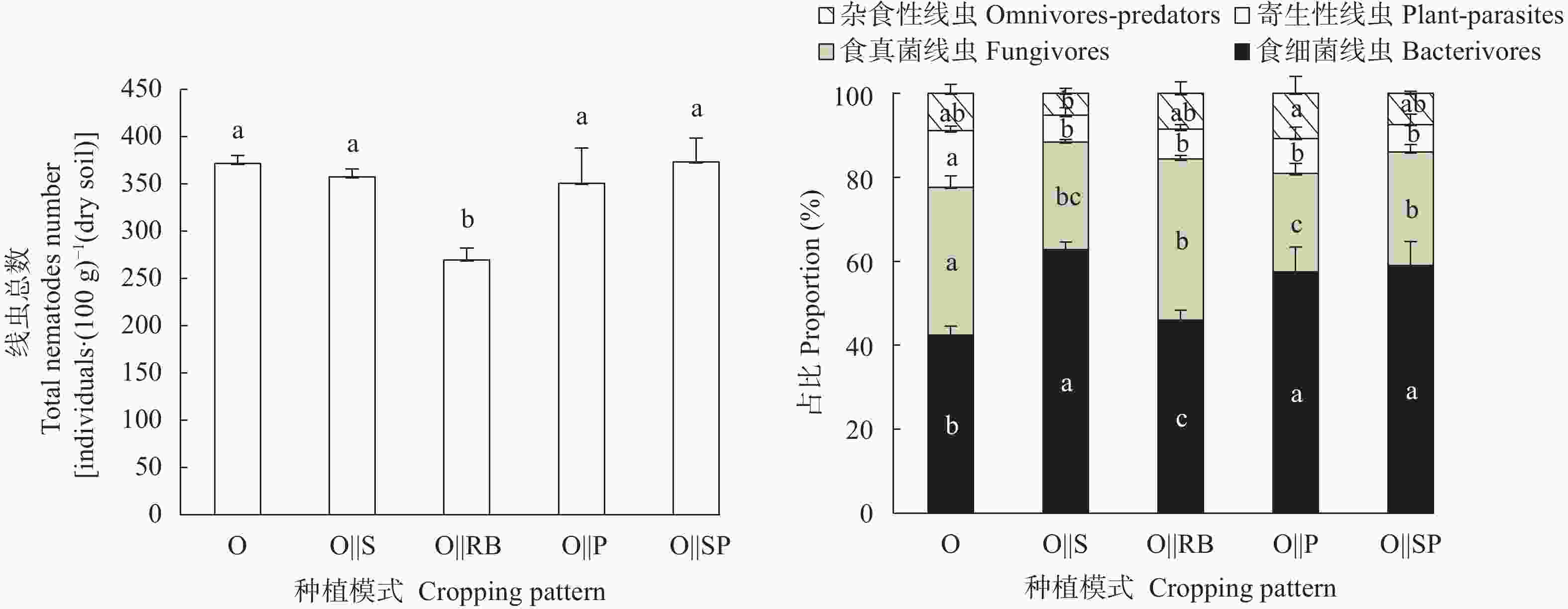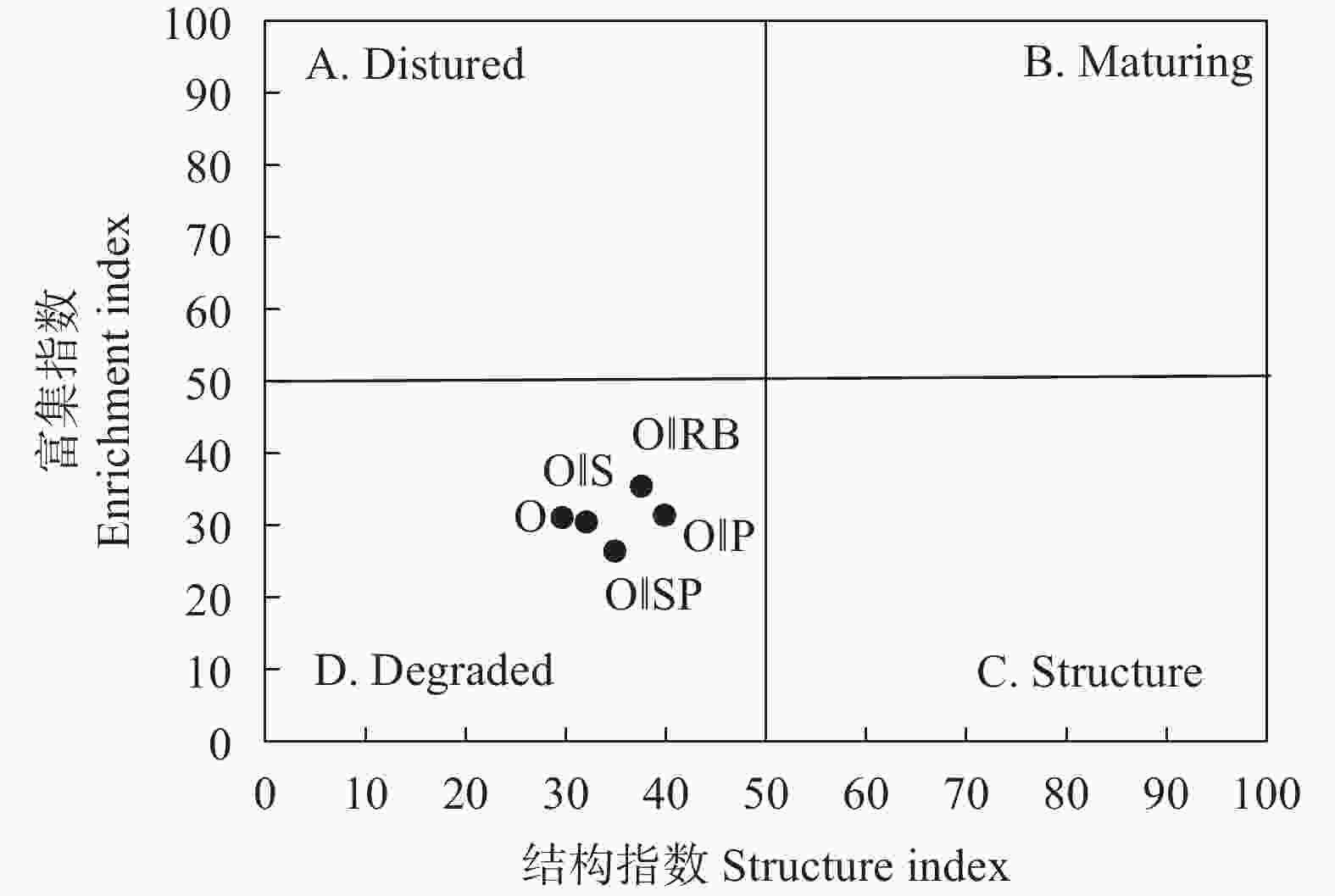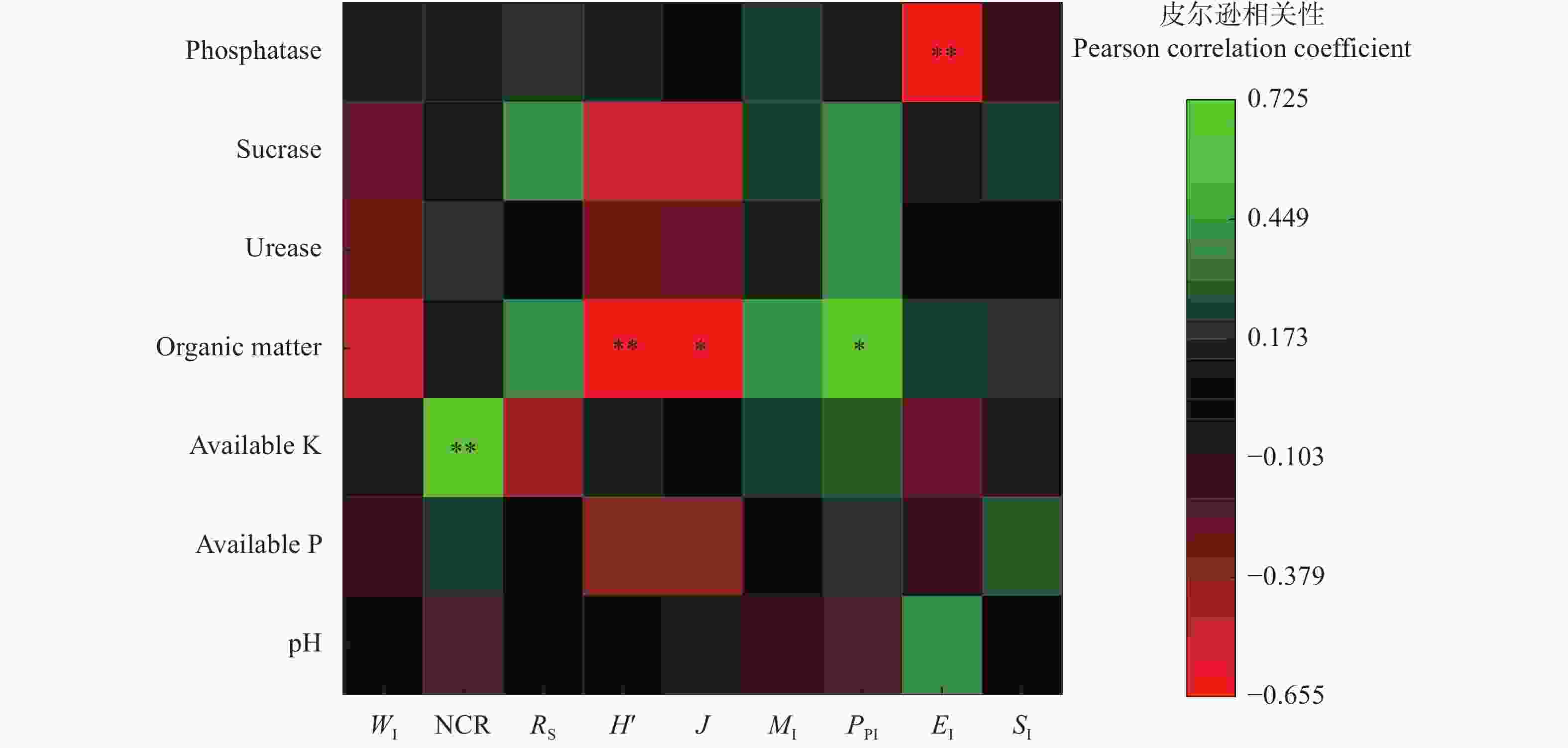Effects of intercropping oat with different crops on the community structure of soil nematodes and crop yields
-
摘要: 间作是土地可持续利用的重要种植模式。土壤线虫作为土壤健康的指示生物, 可揭示地下生态系统的食物网功能。为探究燕麦不同间作模式对产量和土壤线虫群落的影响, 本试验分别设置燕麦单作、燕麦||大豆、燕麦||赤小豆、燕麦||马铃薯和燕麦||甘薯5个处理, 分析燕麦不同间作模式对作物产量以及土壤线虫的数量、多样性和群落结构的影响, 以筛选出较优的燕麦间作模式。结果表明: 相比单作, 间作模式在土地利用率和作物总产量方面有一定的优势, 其中燕麦||马铃薯间作模式最佳, 土地当量比(1.36)最高, 其次为燕麦||大豆间作模式, 土地当量比为1.29。4种燕麦间作模式均显著(P<0.05)降低了植物寄生线虫的相对丰度, 提高了食微线虫相对丰度, 优化了土壤线虫群落结构。燕麦||大豆间作模式下食微线虫比例最高(88.42%), 植物寄生线虫比例最低(6.31%), 且在多项生态指数中(瓦斯乐斯卡指数、线虫通路指数、多样性指数和均匀度指数)显著高于燕麦单作(P<0.05)。而燕麦||赤小豆间作模式下富集指数最高, 植食性线虫成熟度指数最低, 土壤线虫群落受干扰程度最低。速效钾与线虫通路指数呈极显著正相关(r=0.722**), 速效钾含量的提升可以使土壤有机质分解主要依靠细菌分解途径。综上, 间作种植模式可以优化土壤线虫群落结构, 改善土壤生态环境, 提高产量; 燕麦||大豆是该试验条件下最佳的间作模式。Abstract: Intercropping is an important planting method for the sustainable use of land resources, and soil nematodes are an indicator of soil health, which can reveal the function of food webs in underground ecosystems. To explore the effects of different intercropping patterns of oats on yield and soil nematode communities, five treatments were set up: oat monoculture, and intercropping systems of oat||soybean, oat||rice bean, oat||potato, and oat||sweet potato. The effects of different intercropping patterns of oats on crop yield and the number, diversity, and community structure of soil nematodes were analyzed to determine the best intercropping pattern. The results showed that, compared with monoculture, intercropping had certain advantages in terms of land utilization rate and total crop yield. The intercropping of oats and potatoes had the highest land equivalent ratio (1.36), Followed by the intercropping of oats and soybeans, the land equivalent ratio is 1.29. A total of 39 genera were identified, including 12 bacterivorous nematodes, 4 fungivorous nematodes, 13 plant-parasitic nematodes, and 10 omnivorous predatory nematodes. The four oat intercropping patterns significantly reduced the relative abundance of plant-parasitic nematodes, increased the relative abundance of beneficial nematodes (bacterivorous and fungivorous), and optimized the soil nematode community structure. Among them, the best intercropping pattern was oat and soybean, with the highest proportion of microbial-feeding nematodes (88.42%) and the lowest proportion of plant-parasite nematodes (6.31%). Additionally, the intercropping pattern of oat and soybean was significantly higher than that of oat monoculture (P<0.05) in multiple ecological indexes (Wasilewska index, nematode channel ratio, Shannon-Wiener index, and enrichment index), and was also the best among the four intercropping patterns. The enrichment index of oat and rice bean intercropping was the highest, and the plant parasite index was the lowest, indicating that the soil nematode community was the least disturbed. The enrichment index and structure index of each cropping pattern were lower than 50, and the soil nematode food web was in quadrant D, indicating that the soil environment was in a stressed state, the food web was degraded, and the soil nematode community was unstable at the experiment location. Pearson correlation analysis showed that soil nematode community ecological indices were correlated with soil physical and chemical properties. Organic matter was significantly negatively correlated with the evenness index (r=−0.635, P<0.05), significantly negatively correlated with the Shannon-Wiener index (r=−0.641, P<0.01), and significantly positively correlated with the plant parasitic index (r=0.633, P<0.05). There was a significant positive correlation between available K content and the nematode channel ratio (r=0.722, P<0.01), increasing available K content could change the decomposition pathway of soil organic matter and contribute more to the decomposition of soil organic matter. In conclusion, intercropping can optimize the soil nematode community structure, improve the soil ecological environment, and increase crop yield. Among the four intercropping patterns, oat and soybean intercropping were the best method, not only having the highest crop yield but also the most beneficial nematode community structure for soil health, which showed the strong production and ecological advantages of traditional Gramineae and Leguminosae intercropping.
-
图 1 燕麦不同间作模式对土壤线虫总数和各营养类群相对丰度的影响
O: 燕麦单作; O||S: 燕麦||大豆; O||RB: 燕麦||赤小豆; O||P: 燕麦||马铃薯; O||SP: 燕麦||甘薯。不同小写字母表示不同种植模式间差异显著(P<0.05)。O: oat monoculture; O||S: oat||soybean; O||RB: oat||rice beans; O||P: oat||potato; O||SP: oat||sweet potato. Different lowercase letters indicate significant differences among different cropping patterns (P<0.05).
Figure 1. Effects of different intercropping patterns of oat on total number and relative abundance of nutrient groups of soil nematodes
图 2 燕麦不同间作模式的土壤线虫食物网结构富集图
O: 燕麦单作; O||S: 燕麦||大豆; O||RB: 燕麦||赤小豆; O||P: 燕麦||马铃薯; O||SP: 燕麦||甘薯。不同小写字母表示不同种植模式间差异显著(P<0.05)。O: oat monoculture; O||S: oat||soybean; O||RB: oat||rice beans; O||P: oat||potato; O||SP: oat||sweet potato. Different lowercase letters indicate significant differences among different cropping patterns (P<0.05).
Figure 2. Enrichment diagram of food web structure of soil nematodes in different intercropping patterns of oat
图 3 土壤线虫生态指数与土壤理化性质相关性热图
*: 显著相关(P<0.05 ); **: 极显著相关(P<0.01 )。Phosphatase: 磷酸酶; Sucrase: 蔗糖酶; Urease: 脲酶; Organic matter: 有机质; Available K: 速效钾; Available P: 有效磷; WI: 瓦斯乐斯卡指数; NCR: 线虫通路指数; RS: 丰富度指数; H′: 多样性指数; J: 均匀度指数; MI: 自由生活线虫成熟度指数; PPI: 植食性线虫成熟度指数; EI: 富集指数; SI: 结构指数。*: significant correlation at P<0.05; **: significant correlation at P<0.01. WI: Wasilewska index; NCR: nematode channel ratio; RS: species richness index; H′: Shannon-Wiener index; J: evenness index; MI: maturity index; PPI: plant parasite index; EI: enrichment index; SI: structure index.
Figure 3. Heatmap of correlation between soil nematode ecological index and soil physicochemical properties
表 1 燕麦不同间作模式对作物经济产量和土地当量比的影响
Table 1. Effects of different intercropping patterns of oat on crop economic yields and land equivalent ratios
种植模式
Cropping pattern产量 Yield (kg∙hm−2) 土地当量比
Land equivalent
ratio (LER)燕麦 Oat 大豆 Soybean 赤小豆 Rice bean 马铃薯 Potato 甘薯 Sweet potato 单作 Monoculture 2560.15±259.24a 3175.79±246.23a 2797.40±36.58a 26 245.60±2263.32a 25 530.70±997.06a 燕麦||大豆 Oat||soybean 1399.34±109.59c 2351.76±62.40b 1.29 燕麦||赤小豆 Oat||rice bean 1233.96±81.45c 1923.98±107.11b 1.17 燕麦||马铃薯 Oat||potato 1710.14±117.41b 18 087.20±2371.49b 1.36 燕麦||甘薯 Oat||sweet potato 1276.31±75.41c 16 572.20±2628.86b 1.15 间作模式中的作物产量是作物所占间作面积的产量, 同列不同小写字母表示种植模式间差异显著(P<0.05)。The crop yield in the intercropping mode is the yield of the intercropping area occupied by the crop. Different lowercase letters in the same column indicate significant differences among cropping patterns (P<0.05). 表 2 燕麦不同间作模式土壤的线虫群落组成及其相对丰度
Table 2. Soil nematode community composition and relative abundances in different intercropping patterns of oat
营养类群
Trophic
group科
Family属
Genusc-p值
Colonizer-persister
(c-p) value燕麦单作
Oat
monoculture燕麦||大豆
Oat||soybean燕麦||赤小豆
Oat||rice bean燕麦||马铃薯
Oat||potato燕麦||甘薯
Oat||sweet
potato食细菌线虫
Bacterivores小杆科 Rhabditidae 小杆属 Rhabditis 1 ++ ++ ++ ++ ++ 头叶科 Cephalobidae 头叶属 Cephalobus 2 +++ +++ ++ +++ +++ 真头叶属 Eucephalobus 2 ++ ++ ++ ++ ++ 丽突属 Acrobeles 2 ++ ++ ++ ++ + 拟丽突属 Acrobeloides 2 ++ 鹿角唇叶属 Cervidellus 2 ++ ++ ++ ++ ++ 绕线科 Plectidae 绕线属 Plectus 2 ++ ++ ++ ++ ++ 拟绕线属 Anaplectus 2 + ++ ++ ++ 威尔斯属 Wilsonema 2 ++ ++ ++ 畸头叶科 Teratocephalidae
畸头属 Teratocephalus 3 ++ ++ ++ ++ 棱咽科 Prismatolaimidae
棱咽属 Prismatolaimus 3 ++ ++ ++ ++ ++ 无咽科 Alaimidae
无咽属 Alaimus 4 ++ ++ ++ ++ ++ 食真菌线虫
Fungivores滑刃科
Aphelenchoididae滑刃属 Aphelenchoides 2 ++ ++ ++ ++ ++ 真滑刃科 Aphelenchidae
真滑刃属 Aphelenchus 2 +++ +++ +++ +++ ++ 膜皮科 Diphtherophoridae
膜皮属 Diphtherophora 3 ++ ++ ++ ++ ++ 细齿科 Leptonchidae
垫咽属 Tylencholaimus 4 ++ ++ ++ ++ ++ 植物寄生线虫
Plant-parasites垫刃科 Tylenchidae
垫刃属 Tylenchus 2 + 剑尾垫刃属 Malenchus 2 ++ ++ ++ + + 丝尾垫刃属 Filenchus 2 + 野外垫刃属 Aglenchus 2 + + 针科 Paratylenchidae
针属 Paratylenchus 2 ++ ++ + + 锥垫刃科 Tylodoridae
头垫刃属 Cephalenchus 3 ++ ++ + 锥科 Dolichodoridae
矮化属 Tylenchorhynchus 3 + 鞘科 Hemicycliophoridae
鞘属 Hemicycliophora 3 + ++ + 短体科 Pratylenchidae
短体属 Pratylenchus 3 ++ ++ ++ ++ 纽带科 Hoplolaimidae
螺旋属 Helicotylenchus 3 ++ + 毛刺科 Trichodoridae
毛刺属 Trichodorus 4 + ++ ++ ++ + 长针科 Longidoridae
长针属 Longidorus 5 ++ ++ ++ 剑属 Xiphinema 5 + ++ ++ ++ 杂食线虫
Omnivores-predators倒齿科 Anatonchidae
等齿属 Miconchus 4 ++ ++ ++ + 三孔科 Tripylidae
三孔属 Tripyla 4 + ++ ++ + 单齿科 Monochidae
锯齿属 Prionchulus 4 + ++ ++ ++ ++ 锉齿属 Mylonchulus 4 + + 矛线科 Dorylaimidae 前矛线属 Prodorylaimus 4 + ++ + 真矛线属 Eudorylaimus 4 ++ ++ ++ ++ 中矛线属 Mesodorylaimus 4 ++ + 螯属 Pungentus 4 + ++ + 鄂针科 Belondiridae 鄂针属 Belondira 5 ++ ++ ++ + + 缢咽属 Axonchium 5 ++ ++ ++ +++表示丰度>10%, 为优势属; ++表示丰度为1%~10%, 为常见属; +表示丰度<1%, 为稀有属。+++ indicates abundance >10%, the dominant genus; ++ indicates that the abundance is between 1%−10%, the common genus; + indicates abundance <1%, the rare genus. 表 3 燕麦不同间作模式对土壤线虫群落生态指数的影响
Table 3. Effects of different intercropping patterns of oat on ecological indices of soil nematode communities
生态指数
Ecological indice燕麦单作
Oat monoculture燕麦||大豆
Oat||soybean燕麦||赤小豆
Oat||rice bean燕麦||马铃薯
Oat||potato燕麦||甘薯
Oat||sweet potato瓦斯乐斯卡指数 Wasilewska index 5.78±0.21b 14.68±3.51a 12.17±2.25a 10.15±2.19ab 14.28±4.33a 线虫通路指数 Nematode channel ratio 0.55±0.03b 0.71±0.01a 0.55±0.01b 0.71±0.02a 0.69±0.08a 丰富度指数 Species richness index 4.68±0.39a 3.11±0.18c 3.93±0.28b 3.58±0.06b 3.94±0.57b 多样性指数 Shannon-Wiener index 4.94±0.21d 6.27±0.10a 5.72±0.17bc 5.26±0.43cd 5.89±0.30ab 均匀度指数 Evenness index 0.84±0.03b 1.07±0.21a 1.02±0.04a 0.90±0.09b 0.99±0.10a 自由生活线虫成熟度指数 Maturity index 33.54±23.55a 21.55±1.91a 13.39±1.76a 17.41±0.82a 20.05±1.30a 植食性线虫成熟度指数 Plant parasite index 4.54±0.96a 2.42±0.75ab 1.36±0.34b 4.02±2.28a 2.08±1.18ab 同行不同小写字母表示不同处理间差异显著(P<0.05)。Different lowercase letters in the same row indicate significant differences among different cropping patterns atP<0.05 level. -
[1] LITHOURGIDIS A, DORDAS C, DAMALAS C A, et al. Annual intercrops: an alternative pathway for sustainable agriculture[J]. Australian Journal of Crop Science, 2011, 5: 396−410 [2] 姜圆圆, 郑毅, 汤利, 等. 豆科禾本科作物间作的根际生物过程研究进展[J]. 农业资源与环境学报, 2016, 33(5): 407−415JIANG Y Y, ZHENG Y, TANG L, et al. Rhizosphere biological processes of legume| | cereal intercropping systems: a review[J]. Journal of Agricultural Resources and Environment, 2016, 33(5): 407−415 [3] 高阳, 段爱旺, 刘祖贵, 等. 单作和间作对玉米和大豆群体辐射利用率及产量的影响[J]. 中国生态农业学报, 2009, 17(1): 7−12 doi: 10.3724/SP.J.1011.2009.00007GAO Y, DUAN A W, LIU Z G, et al. Effect of monoculture and intercropping on radiation use efficiency and yield of maize and soybean[J]. Chinese Journal of Eco-Agriculture, 2009, 17(1): 7−12 doi: 10.3724/SP.J.1011.2009.00007 [4] JENSEN E S, CARLSSON G, HAUGGAARD-NIELSEN H. Intercropping of grain legumes and cereals improves the use of soil N resources and reduces the requirement for synthetic fertilizer N: a global-scale analysis[J]. Agronomy for Sustainable Development, 2020, 40(1): 1−9 doi: 10.1007/s13593-019-0604-0 [5] FRANCIS C A. Multiple Cropping Systems[M]. New York: Macmillan Publishing Company, 1986 [6] ZOMER R A, TRABUCCO A, COE R, et al. Trees on Farm: Analysis of Global Extent and Geographical Patterns of Agroforestry ICRAF Working Paper No. 89[R]. World Agroforestry Centre (ICRAF), 2009 [7] 徐长林. 高寒牧区不同燕麦品种生长特性比较研究[J]. 草业学报, 2012, 21(2): 280−285 doi: 10.11686/cyxb20120236XU C L. A study on growth characteristics of different cultivars of oat (Avena sativa) in alpine region[J]. Acta Prataculturae Sinica, 2012, 21(2): 280−285 doi: 10.11686/cyxb20120236 [8] 冯晓敏, 杨永, 任长忠, 等. 豆科–燕麦间作对作物光合特性及籽粒产量的影响[J]. 作物学报, 2015, 41(9): 1426−1434 doi: 10.3724/SP.J.1006.2015.01426FENG X M, YANG Y, REN C Z, et al. Effects of legumes intercropping with oat on photosynthesis characteristics of and grain yield[J]. Acta Agronomica Sinica, 2015, 41(9): 1426−1434 doi: 10.3724/SP.J.1006.2015.01426 [9] 杨学超, 胡跃高, 钱欣, 等. 施氮量对绿豆‖燕麦间作系统生产力及氮吸收累积的影响[J]. 中国农业大学学报, 2012, 17(4): 46−52 doi: 10.11841/j.issn.1007-4333.2012.04.008YANG X C, HU Y G, QIAN X, et al. Effects of nitrogen application level on system productivity, nitrogen absorption and accumulation in mung bean‖oat intercropping system[J]. Journal of China Agricultural University, 2012, 17(4): 46−52 doi: 10.11841/j.issn.1007-4333.2012.04.008 [10] 冯晓敏, 杨永, 任长忠, 等. 燕麦/大豆和燕麦/花生间作对根际土壤固氮细菌多样性与群落结构的影响[J]. 中国农业大学学报, 2016, 21(1): 22−32 doi: 10.11841/j.issn.1007-4333.2016.01.03FENG X M, YANG Y, REN C Z, et al. Effects of oat-soybean and oat-groundnut intercropping on the diversity and community composition of soil nitrogen-fixing bacterial in rhizosphere soil[J]. Journal of China Agricultural University, 2016, 21(1): 22−32 doi: 10.11841/j.issn.1007-4333.2016.01.03 [11] 王旭, 曾昭海, 朱波, 等. 燕麦与箭筈豌豆不同混作模式对根际土壤微生物数量的影响[J]. 草业学报, 2009, 18(6): 151−157 doi: 10.3321/j.issn:1004-5759.2009.06.020WANG X, ZENG Z H, ZHU B, et al. Effects of oat mixed with common vetch on the microorganism populations in rhizosphere soil[J]. Acta Prataculturae Sinica, 2009, 18(6): 151−157 doi: 10.3321/j.issn:1004-5759.2009.06.020 [12] 傅声雷. 土壤生物多样性的研究概况与发展趋势[J]. 生物多样性, 2007, 15(2): 109−115 doi: 10.3321/j.issn:1005-0094.2007.02.001FU S L. A review and perspective on soil biodiversity research[J]. Biodiversity Science, 2007, 15(2): 109−115 doi: 10.3321/j.issn:1005-0094.2007.02.001 [13] 时雷雷, 傅声雷. 土壤生物多样性研究: 历史、现状与挑战[J]. 科学通报, 2014, 59(6): 493−509 doi: 10.1360/972013-266SHI L L, FU S L. Review of soil biodiversity research: history, current status and future challenges[J]. Chinese Science Bulletin, 2014, 59(6): 493−509 doi: 10.1360/972013-266 [14] FRECKMAN D W. Bacterivorous nematodes and organic-matter decomposition[J]. Agriculture, Ecosystems & Environment, 1988, 24(1/2/3): 195−217 [15] 宋敏, 刘银占, 井水水. 土壤线虫对气候变化的响应研究进展[J]. 生态学报, 2015, 35(20): 6857−6867SONG M, LIU Y Z, JING S S. Response of soil nematodes to climate change: a review[J]. Acta Ecologica Sinica, 2015, 35(20): 6857−6867 [16] 刘艳方, 刘攀, 王文颖, 等. 土壤线虫作为生态指示生物的研究进展[J]. 生态科学, 2020, 39(2): 207−214LIU Y F, LIU P, WANG W Y, et al. The research progress of soil nematodes as ecological indicator organisms[J]. Ecological Science, 2020, 39(2): 207−214 [17] 钱复生, 王宗英. 水东枣园土壤动物与土壤环境的关系[J]. 应用生态学报, 1995, 6(1): 44−50 doi: 10.3321/j.issn:1001-9332.1995.01.007QIAN F S, WANG Z Y. Relationship between soil fauna and soil environment in jujube garden in Shuidong, Anhui Province[J]. Chinese Journal of Applied Ecology, 1995, 6(1): 44−50 doi: 10.3321/j.issn:1001-9332.1995.01.007 [18] 杨再福, 喻会平, 刘杰, 等. 烟草间作万寿菊对根结线虫的控制及土壤线虫群落的影响[J]. 山地农业生物学报, 2021, 40(2): 16−20YANG Z F, YU H P, LIU J, et al. The effectiveness of tobacco marigold intercropping for root-knot nematode control and soil nematode community[J]. Journal of Mountain Agriculture and Biology, 2021, 40(2): 16−20 [19] 陆秀红, 黄金玲, 胡钧铭, 等. 香蕉绿豆间作对根际线虫的影响[C]//中国植物病理学会2015年学术年会论文集. 海口, 2015: 445LU X H, HUANG J L, HU J M, et al. Effects of banana and mung bean intercropping on rhizosphere nematodes [C]//Proceedings of the 2015 Annual Academic Conference of the Chinese Society of Plant Pathology. Haikou, 2015: 445 [20] 封亮, 黄国勤, 杨文亭, 等. 江西红壤旱地玉米||大豆间作模式对作物产量及种间关系的影响[J]. 中国生态农业学报(中英文), 2021, 29(7): 1127−1137FENG L, HUANG G Q, YANG W T, et al. Yields and interspecific relationship of the maize-soybean intercropping system in the upland red soil of Jiangxi Province[J]. Chinese Journal of Eco-Agriculture, 2021, 29(7): 1127−1137 [21] 任媛媛, 王志梁, 王小林, 等. 黄土塬区玉米大豆不同间作方式对产量和经济收益的影响及其机制[J]. 生态学报, 2015, 35(12): 4168−4177REN Y Y, WANG Z L, WANG X L, et al. The effect and mechanism of intercropping pattern on yield and economic benefit on the Loess Plateau[J]. Acta Ecologica Sinica, 2015, 35(12): 4168−4177 [22] 王庆宇, 李立军, 阮慧, 等. 旱地燕麦间作对土壤酶活性、微生物含量及产量的影响[J]. 干旱地区农业研究, 2019, 37(2): 179−184 doi: 10.7606/j.issn.1000-7601.2019.02.26WANG Q Y, LI L J, RUAN H, et al. Effects of intercropping of oat on soil enzyme activity, microbial content and yield in arid land[J]. Agricultural Research in the Arid Areas, 2019, 37(2): 179−184 doi: 10.7606/j.issn.1000-7601.2019.02.26 [23] 鲍士旦. 土壤农化分析[M]. 3版. 北京: 中国农业出版社, 2000BAO S D. Soil and Agricultural Chemistry Analysis[M]. Beijing: China Agriculture Press, 2000 [24] 关松荫. 土壤酶及其研究法[M]. 北京: 农业出版社, 1986GUAN S Y. Soil Enzyme and Its Research Method[M]. Beijing: Agriculture Press, 1986 [25] MARTIN J P. Nematology-fundamentals and recent advances with emphasis on plant parasitic and soil forms[J]. Soil Science Society of America Journal, 1960, 54(2): 184 [26] 谢辉. 植物线虫分类学[M]. 北京: 高等教育出版社, 2005XIE H. Taxonomy of Plant Nematodes[M]. Beijing: Higher Education Press, 2005 [27] 尹文英. 中国土壤动物检索图鉴[M]. 北京: 科学出版社, 1998YIN W Y. Pictorical Keys to Soil Animals of China[M]. Beijing: Science Press, 1998 [28] BONGERS T. The maturity index: an ecological measure of environmental disturbance based on nematode species composition[J]. Oecologia, 1990, 83(1): 14−19 doi: 10.1007/BF00324627 [29] NEHER D A. Role of nematodes in soil health and their use as indicators[J]. Journal of Nematology, 2001, 33(4): 161−168 [30] YEATES G W. Nematodes as soil indicators: functional and biodiversity aspects[J]. Biology and Fertility of Soils, 2003, 37(4): 199−210 doi: 10.1007/s00374-003-0586-5 [31] 薛会英, 胡锋, 罗大庆. 藏北高寒草甸植物群落对土壤线虫群落的影响[J]. 土壤学报, 2013, 50(3): 507−516 doi: 10.11766/trxb201207280305XUE H Y, HU F, LUO D Q. Effect of plant community on soil nematode community in alpine meadows in North Tibet[J]. Acta Pedologica Sinica, 2013, 50(3): 507−516 doi: 10.11766/trxb201207280305 [32] 李玉娟. 云南哀牢山土壤线虫对植物群落改变及地上/地下资源输入的响应[D]. 上海: 复旦大学, 2008: 1–141LI Y J. Responses of soil nematodes to plant community changes and above/belowground resource inputs in Ailao Mountains, Yunnan[D]. Shanghai: Fudan University, 2008: 1–141 [33] 李玉娟, 吴纪华, 陈慧丽, 等. 线虫作为土壤健康指示生物的方法及应用[J]. 应用生态学报, 2005, 16(8): 1541−1546 doi: 10.3321/j.issn:1001-9332.2005.08.031LI Y J, WU J H, CHEN H L, et al. Nematodes as bioindicator of soil health: methods and applications[J]. Chinese Journal of Applied Ecology, 2005, 16(8): 1541−1546 doi: 10.3321/j.issn:1001-9332.2005.08.031 [34] FERRIS H, BONGERS T, DE GOEDE R G M. A framework for soil food web diagnostics: extension of the nematode faunal analysis concept[J]. Applied Soil Ecology, 2001, 18(1): 13−29 doi: 10.1016/S0929-1393(01)00152-4 [35] LITHOURGIDIS A S, VLACHOSTERGIOS D N, DORDAS C A, et al. Dry matter yield, nitrogen content, and competition in pea-cereal intercropping systems[J]. European Journal of Agronomy, 2011, 34(4): 287−294 doi: 10.1016/j.eja.2011.02.007 [36] KIMARO A A, TIMMER V R, CHAMSHAMA S A O, et al. Competition between maize and pigeonpea in semi-arid Tanzania: effect on yields and nutrition of crops[J]. Agriculture, Ecosystems & Environment, 2009, 134(1/2): 115−125 [37] WADDINGTON S R, MEKURIA M, SIZIBA S, et al. Long-term yield sustainability and financial returns from grain legume– maize intercrops on a sandy soil in subhumid north central Zimbabwe[J]. Experimental Agriculture, 2007, 43(4): 489−503 doi: 10.1017/S0014479707005303 [38] 乔月静, 郭来春, 葛军勇, 等. 燕麦与豆科作物间作对土壤酶活和微生物量的影响[J]. 甘肃农业大学学报, 2020, 55(3): 54−61QIAO Y J, GUO L C, GE J Y, et al. Effects of oat-legume intercropping on soil enzyme activities and abundance of soil microbe[J]. Journal of Gansu Agricultural University, 2020, 55(3): 54−61 [39] 乔月静, 刘琪, 曾昭海, 等. 轮作方式对甘薯根际土壤线虫群落结构及甘薯产量的影响[J]. 中国生态农业学报(中英文), 2019, 27(1): 20−29QIAO Y J, LIU Q, ZENG Z H, et al. Effect of rotation on nematode community diversity in rhizosphere soils and yield of sweet potato[J]. Chinese Journal of Eco-Agriculture, 2019, 27(1): 20−29 [40] 张亚楠, 李孝刚, 王兴祥. 茅苍术间作对连作花生土壤线虫群落的影响[J]. 土壤学报, 2016, 53(6): 1497−1505 doi: 10.11766/trxb201603020025ZHANG Y N, LI X G, WANG X X. Effects of interplanting of Atractylodes lancea in monocultured peanut fields on soil nematode community[J]. Acta Pedologica Sinica, 2016, 53(6): 1497−1505 doi: 10.11766/trxb201603020025 [41] 宋成军, 孙锋. 干旱对不同花椒种植模式下土壤微生物和线虫群落的影响[J]. 生物多样性, 2021, 29(10): 1348−1357 doi: 10.17520/biods.2021121SONG C J, SUN F. Effects of Zanthoxylum bungeanum agroforestry systems on soil microbial and nematode communities under drought[J]. Biodiversity Science, 2021, 29(10): 1348−1357 doi: 10.17520/biods.2021121 [42] 张晓珂, 梁文举, 李琪. 我国土壤线虫生态学研究进展和展望[J]. 生物多样性, 2018, 26(10): 1060−1073 doi: 10.17520/biods.2018082ZHANG X K, LIANG W J, LI Q. Recent progress and future directions of soil nematode ecology in China[J]. Biodiversity Science, 2018, 26(10): 1060−1073 doi: 10.17520/biods.2018082 [43] 钟爽, 何应对, 韩丽娜, 等. 连作年限对香蕉园土壤线虫群落结构及多样性的影响[J]. 中国生态农业学报, 2012, 20(5): 604−611 doi: 10.3724/SP.J.1011.2012.00604ZHONG S, HE Y D, HAN L N, et al. Effect of continuous cropping of banana on soil nematode community structure and diversity[J]. Chinese Journal of Eco-Agriculture, 2012, 20(5): 604−611 doi: 10.3724/SP.J.1011.2012.00604 [44] VERSCHOOR B C, De GOEDE R G M. The nematode extraction efficiency of the Oostenbrink elutriator cottonwool filter method with special reference to nematode body size and life strategy[J]. Nematology, 2000, 2(3): 325−342 doi: 10.1163/156854100509204 -






 下载:
下载:





